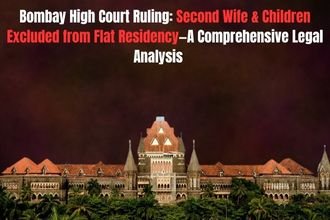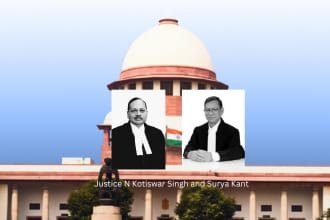In a significant judgment reflecting the complexities of property rights and family law in India, the Bombay High Court recently addressed a housing rights dispute involving a man, his first wife, second wife, children, and mother. The Court ruled that only the man and his mother are allowed to reside in the flat, effectively excluding the second wife and her children from residency. This ruling highlights the careful balance courts must maintain between legal property ownership, familial rights, and emotional considerations in cases of multiple marriages and cohabitation disputes.
Background of the Case
The dispute originated when a man, the owner of a flat in Mumbai, faced objections from his first wife regarding the presence of his second wife and children from the second marriage in the same residence. The first wife contended that the presence of the second family would cause emotional distress and disruption, particularly during the festival season, while the second wife claimed a right to reside in the flat based on the husband’s ownership. The legal conflict escalated, prompting intervention from the Bombay High Court to resolve this sensitive family issue.
Court’s Judgment
The Bombay High Court delivered a careful and nuanced ruling. The Court allowed the man and his mother to stay in the flat but explicitly excluded the second wife and children. This arrangement was intended to be temporary, particularly for the Diwali festival period, to ensure that familial harmony was maintained and potential conflicts were minimized. The Court highlighted that while ownership of property is a key factor in determining residency rights, it cannot be considered in isolation from the social and emotional dynamics of the families involved.
Justice presiding over the case noted that the first wife had not objected to the man and his mother residing in the flat but had concerns about the second wife and children living there. Consequently, the ruling reflects the Court’s efforts to balance property rights with fairness and familial considerations.
Legal Principles Highlighted by the Case
This case underscores several critical legal principles:
1. Property Rights vs. Family Considerations
While the man owns the flat, the Court considered not only legal ownership but also the emotional and psychological well-being of the first wife. Indian courts have repeatedly acknowledged that property rights may need to be exercised in a manner that respects the rights and concerns of other family members. This principle ensures that property ownership does not become a source of conflict but is harmonized with equitable family considerations.
2. Family Law and Polygamy
Although polygamy is largely prohibited under Indian law for Hindus and other communities, exceptions exist for certain personal laws or under special circumstances. In cases where multiple spouses are involved, courts carefully consider each party’s rights, including residency, maintenance, and emotional well-being. This ruling exemplifies how the judiciary navigates the delicate intersection of property law, personal law, and marital status.
3. Temporary Relief and Preventive Measures
The Court’s order provided a temporary solution for the festival season, illustrating the judiciary’s approach of issuing interim directions that maintain peace and prevent escalation while allowing time for parties to pursue permanent legal remedies. Temporary reliefs are often used in family disputes to ensure immediate resolution and prevent harm while longer-term solutions are considered.
4. Maintaining Familial Harmony
The decision reflects the Court’s broader mandate to promote harmony within families. While legal entitlements are critical, Indian courts increasingly recognize that resolving disputes in a manner that maintains social stability and minimizes emotional distress is equally important. The emphasis on familial harmony demonstrates the judiciary’s human-centered approach in resolving domestic disputes.
Broader Implications of the Judgment
This ruling has several significant implications:
For Property Owners
Property owners in similar situations must recognize that mere ownership does not automatically entitle all family members to reside in the property. Courts may consider prior objections from existing family members, emotional and psychological considerations, and the potential for conflict. Owners must be prepared to balance their legal rights with familial responsibilities, particularly in cases involving multiple marriages or cohabiting family members.
For Family Law Practitioners
Lawyers handling family disputes should note the Court’s emphasis on temporary, precautionary measures that protect all parties’ interests. Drafting petitions and interim applications in such cases requires careful articulation of ownership rights, cohabitation concerns, and potential emotional harm. This case demonstrates the importance of presenting a balanced argument that considers both legal and human factors.
For Courts
The Bombay High Court’s ruling sets a precedent for similar disputes, particularly in metropolitan areas where housing scarcity can exacerbate family conflicts. Courts may increasingly issue interim orders that provide temporary arrangements to minimize conflict while permanent solutions are pursued. This approach promotes fairness and reduces the likelihood of escalation or violence in domestic disputes.
Social and Cultural Implications
This judgment also reflects the broader social and cultural challenges associated with multiple marriages and blended families in India. Courts are being called upon to resolve disputes that arise from evolving family structures and changing social norms. The decision demonstrates sensitivity to traditional family expectations while respecting modern legal rights.
Related Precedents
The judgment aligns with several other legal decisions in India:
- Daughters’ Right to Residence: The Bombay High Court has previously affirmed the absolute right of daughters to reside in their father’s property, recognizing moral obligations as translating into legal ownership under the Hindu Succession Act.
- Under-Construction Flats and Domestic Violence Act: The Court has ruled that a flat under construction does not qualify as a ‘shared household’ under the Domestic Violence Act, highlighting how the nature and use of property can influence residency rights.
- Maintenance Rights for Second Wives: The Court has held that a second wife can claim maintenance under Section 125 of the CrPC, emphasizing that legal rights can exist even in cases where marriages are not formally dissolved.
These precedents collectively illustrate how Indian courts carefully balance ownership, familial rights, and statutory protections to achieve fair outcomes.
Conclusion
The Bombay High Court’s ruling in this housing rights dispute provides a nuanced legal framework for handling similar family conflicts. By granting residency rights exclusively to the man and his mother while excluding the second wife and her children, the Court demonstrated a balanced approach that considers legal ownership, emotional well-being, and social harmony.
For families and legal practitioners alike, this case serves as an important reference point in understanding the interaction between property rights, family law, and societal norms. The decision reinforces the principle that legal resolutions must be sensitive to the broader context in which disputes arise, including emotional, social, and cultural dimensions.
As India continues to navigate the complexities of modern family structures, rulings like this provide guidance on managing conflicts in a way that upholds justice while fostering familial harmony. Parties involved in such disputes must carefully consider both their legal rights and the potential social consequences of their actions, ensuring that resolution is fair, balanced, and sustainable.
Also Read



